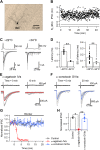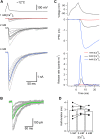Nanodomain coupling explains Ca²⁺ independence of transmitter release time course at a fast central synapse
- PMID: 25487988
- PMCID: PMC4270082
- DOI: 10.7554/eLife.04057
Nanodomain coupling explains Ca²⁺ independence of transmitter release time course at a fast central synapse
Abstract
A puzzling property of synaptic transmission, originally established at the neuromuscular junction, is that the time course of transmitter release is independent of the extracellular Ca(2+) concentration ([Ca(2+)]o), whereas the rate of release is highly [Ca(2+)]o-dependent. Here, we examine the time course of release at inhibitory basket cell-Purkinje cell synapses and show that it is independent of [Ca(2+)]o. Modeling of Ca(2+)-dependent transmitter release suggests that the invariant time course of release critically depends on tight coupling between Ca(2+) channels and release sensors. Experiments with exogenous Ca(2+) chelators reveal that channel-sensor coupling at basket cell-Purkinje cell synapses is very tight, with a mean distance of 10-20 nm. Thus, tight channel-sensor coupling provides a mechanistic explanation for the apparent [Ca(2+)]o independence of the time course of release.
Keywords: Ca2+ channels; GABAergic synapses; cerebellar basket cells; mouse; nanodomain coupling; neuroscience; release sensors; time course of transmitter release.
Conflict of interest statement
The authors declare that no competing interests exist.
Figures







Similar articles
-
Triple Function of Synaptotagmin 7 Ensures Efficiency of High-Frequency Transmission at Central GABAergic Synapses.Cell Rep. 2017 Nov 21;21(8):2082-2089. doi: 10.1016/j.celrep.2017.10.122. Cell Rep. 2017. PMID: 29166601 Free PMC article.
-
Nanodomain coupling between Ca2+ channels and Ca2+ sensors promotes fast and efficient transmitter release at a cortical GABAergic synapse.Neuron. 2008 Feb 28;57(4):536-45. doi: 10.1016/j.neuron.2007.12.026. Neuron. 2008. PMID: 18304483
-
Developmental tightening of cerebellar cortical synaptic influx-release coupling.J Neurosci. 2015 Feb 4;35(5):1858-71. doi: 10.1523/JNEUROSCI.2900-14.2015. J Neurosci. 2015. PMID: 25653347 Free PMC article.
-
Ca(2+) channels and transmitter release at the active zone.Cell Calcium. 2012 Sep-Oct;52(3-4):199-207. doi: 10.1016/j.ceca.2012.04.011. Epub 2012 Jun 8. Cell Calcium. 2012. PMID: 22682961 Review.
-
Nanodomain coupling between Ca²⁺ channels and sensors of exocytosis at fast mammalian synapses.Nat Rev Neurosci. 2011 Dec 20;13(1):7-21. doi: 10.1038/nrn3125. Nat Rev Neurosci. 2011. PMID: 22183436 Free PMC article. Review.
Cited by
-
Functional specificity of liquid-liquid phase separation at the synapse.Nat Commun. 2024 Nov 21;15(1):10103. doi: 10.1038/s41467-024-54423-7. Nat Commun. 2024. PMID: 39572583 Free PMC article.
-
Triple Function of Synaptotagmin 7 Ensures Efficiency of High-Frequency Transmission at Central GABAergic Synapses.Cell Rep. 2017 Nov 21;21(8):2082-2089. doi: 10.1016/j.celrep.2017.10.122. Cell Rep. 2017. PMID: 29166601 Free PMC article.
-
EGTA Can Inhibit Vesicular Release in the Nanodomain of Single Ca2+ Channels.Front Synaptic Neurosci. 2019 Oct 1;11:26. doi: 10.3389/fnsyn.2019.00026. eCollection 2019. Front Synaptic Neurosci. 2019. PMID: 31632263 Free PMC article.
-
Synaptotagmin Ca2+ Sensors and Their Spatial Coupling to Presynaptic Cav Channels in Central Cortical Synapses.Front Mol Neurosci. 2019 Jan 15;11:494. doi: 10.3389/fnmol.2018.00494. eCollection 2018. Front Mol Neurosci. 2019. PMID: 30697148 Free PMC article. Review.
-
Molecular Machines Regulating the Release Probability of Synaptic Vesicles at the Active Zone.Front Synaptic Neurosci. 2016 Mar 2;8:5. doi: 10.3389/fnsyn.2016.00005. eCollection 2016. Front Synaptic Neurosci. 2016. PMID: 26973506 Free PMC article. Review.
References
Publication types
MeSH terms
Substances
Grants and funding
LinkOut - more resources
Full Text Sources
Other Literature Sources
Miscellaneous

